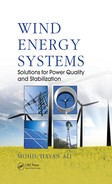Preface
This book provides fundamental concepts of wind energy conversion systems and discusses grid integration and stability issues, methods of transient stability enhancement and minimization of fluctuations of power, and frequency and voltage of wind generator systems. Recently, electricity generation using wind power has received much attention all over the world. Wind energy is a free, renewable resource, so no matter how much is used today there will still be the same supply in the future. Wind energy is also a source of clean, nonpolluting electricity. Unlike conventional power plants, wind plants emit no air pollutants or greenhouse gases.
Induction machines are mostly used as wind generators. However, induction generators have stability problems similar to the transient stability of synchronous machines. During a fault in the power network, rotor speed of the wind generator goes very high, active power output goes very low, and terminal voltage goes low or collapses down. Usually the wind generator is shut down during these emergency situations. Recent tradition is not to shut down the wind generator during a network fault but to keep it connected to the grid through appropriate control. This clearly indicates that wind generator stabilization is necessary during network faults. Again, even though there is no fault in the network, due to random wind speed variations, output power, frequency, and terminal voltage of wind generators fluctuate. However, consumers desire to have constant voltage and frequency. Therefore, some control means are necessary to minimize power, frequency, and voltage fluctuations. This book discusses several means to enhance the transient stability of wind generator system and also explains the methodologies for minimizing fluctuations of power, frequency, and voltage.
The book is organized as follows. Chapter 1 provides a general overview of wind energy and outlines the background, aim, and scope of the book. Chapter 2 describes the fundamental concept of wind energy conversion systems and modeling of wind turbines. Electric machines—in particular induction machines and synchronous machines—are the key to wind energy conversion systems. Therefore, the basic concepts of electrical machines are discussed in Chapter 3. With the variable-speed wind generator system, the terminal of the generator is connected to the grid through a power electronics interface. Also, to integrate the energy storage system into the wind generator system, power electronics is necessary. Thus, Chapter 4 deals with a brief overview and fundamental concepts of power electronics devices. The types of wind generator systems are discussed in Chapter 5.
Chapter 6 discusses the grid integration issues of wind generator systems. In particular, the transient stability issue, power quality problem, fluctuations of power, frequency, and voltage of wind generator systems during random wind speed variations are described. Chapter 7 analyzes the solutions for power quality issues of wind generator systems, especially minimization of fluctuations of power, voltage, and frequency of wind generators during random wind speed variations by energy storage devices. Chapter 8 describes the various methods of transient stability enhancement of wind generator systems during network faults. Simulation results are provided to demonstrate the effectiveness of the stabilization methods. Comparisons among the stabilization methods are made on the basis of performance, control structure, and cost. Chapter 9 deals with the fault-ride through capability and mitigation of power fluctuations of variable-speed wind generator systems, especially for doubly fed induction generator systems, wound-field synchronous generator systems, and permanent magnet synchronous generator systems.
This book is intended to discuss various means of wind generator stabilization and the means to minimize power, frequency, and voltage fluctuations of wind generator systems. A comparison of stabilization tools is also given; thus, it will help the researchers and engineers understand the relative effectiveness of the stabilization methods and then select a suitable tool for wind generator stabilization. This book can also serve as a good reference for wind generator systems for graduate as well as undergraduate students. Through this book, these students will gain insight into grid integration and stability issues and various methods of stabilization of wind generator systems and can apply the knowledge they gain from this book in their own research. Thus, it is hoped this book will be of great interest and be very helpful for researchers, engineers, and students who research wind energy systems.
The author cordially invites any constructive criticism of or comments about the book.
